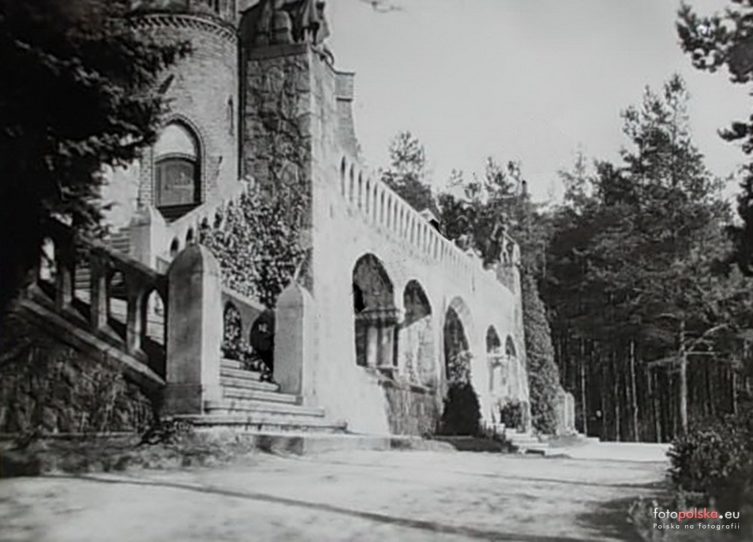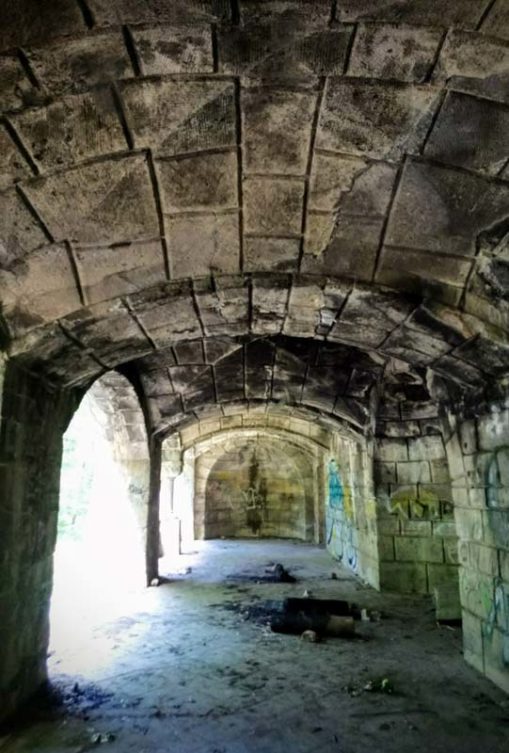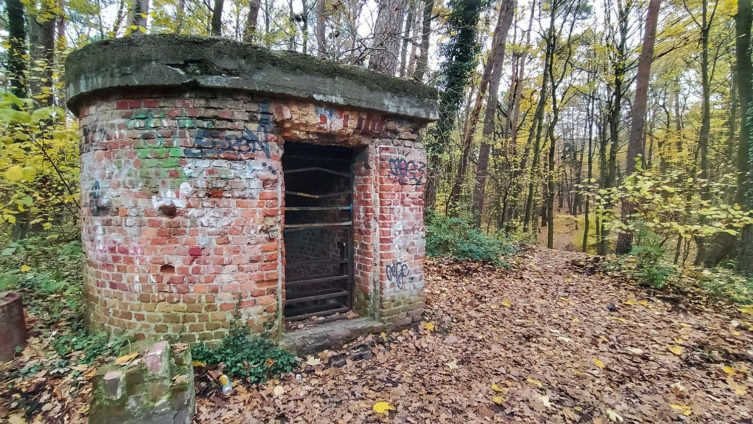Quistorp Tower - interesting facts, map, access

Attraction that died
At the beginning of the XNUMXth century, the Quistorp Tower was one of the most famous buildings in Szczecin. It was a tourist attraction and a very popular place of rest for the residents of Szczecin.
Situated in a beautiful natural setting, on the top of Arkona Hill, from which there was a vast view of Szczecin, it attracted visitors and locals.
A wide, comfortable walking alley led to the tower from today's Arkońska Street. As we approached the tower, the steepness of the approach increased, so the avenue in this part took the form of wide steps. Alleys have been marked out in the area surrounding the tower and planted with garden plants.
The tower was so popular that in Szczecin you could buy souvenir postcards with its view. It is significant that nowadays you can find a lot of materials showing the view of the tower in its full glory. However, there are no pictures anywhere to show what the view stretched from the top of the tower. We can only believe that it was spectacular.

photo source: fotopolska.eu
Tower or Monument?
In fact, it's both. The Quistorp Tower is a monument that the son erected for his father to commemorate.
Father: Johannes Quistorp
... was a very famous and extremely influential entrepreneur from Szczecin. Here he founded and developed his business from scratch.
The end of the XNUMXth century was the time when Szczecin was one of the largest cement production centers in Germany. At that time, she ran one of the most famous mines and cement plants in the area The Bukowa Primeval Forest the Toepffer family (the effect is Szmaragdowe Lake - [click], i.e. the flooded excavation of the former Toepffer mine). The Quistorp family had their own, equally profitable cement business. Johannes founded and developed the "Lebbin" cement plant in Lubin (a small village on the island of Wolin). The excavation from which the raw material for cement production was extracted was located near the present town of Wapnica. Currently there is… a lake of course! Called Turquoise Lake and due to the proximity of Międzyzdroje, it is a popular attraction for holidaymakers.
Cement production was then very profitable. Jochanes Quistorp grew rich quickly, he opened new enterprises (including a brickyard and a construction company), which made him get rich even faster. He bought land and had a significant impact on the fate of Szczecin.
On his initiative, new districts of Szczecin were created: Westend, Neu Westend and Braunsfelde (currently these are the western part of the center, Łękno and Pogodno, respectively).
The most famous park in Szczecin was created on the land he had donated to the city: Kasprowicz Park (then it was called Quistorp Park).
Quite unusual for those times was Johannes Quistorp's approach to the social issues of his employees. He allocated enormous funds for the construction of schools, care centers, orphanages, shelters, foundations ... With his money, the "Bethanien" Care Center was established in Szczecin, which in practice was a hospital and care center composed of several (!!!) buildings. Buildings still exist today. They are situated between Mickiewicza Street and Wawrzyniaka Street. They currently house many companies, organizations and institutions, including: the Consulate of Ukraine, the Academic Center of the Pomeranian Association for Promotion and Science, the Goethe-Institut Examination Center, the State Dormitory for Artistic Schools and the Club of the 12th Mechanized Division of Szczecin.
Son: Martin Quistorp
... in short, it can be said that he continued the thought and work of his father. He was the heir not only of the property but also of its ideas. He successfully developed the inherited enterprise, adding further profitable branches to it (power plant, waterworks, slaughterhouse, wine cellars, restaurants). He devoted huge resources to social activities and philanthropy. It also significantly influenced the development of the city.
He financed the construction Kasprowicz Park and sold the city the land for the construction of the current City Hall (the so-called Green Town Hall), initiating the process of creating the architectural layout of the new part of the city.

photo source: fotopolska.eu

Tower
It is not difficult to understand that by sharing his father's life philosophy, Martin must have felt the need to pay his father a kind of homage in the form of a permanent construction memento. Their whole life was associated with the construction industry and it was the source of their success from the very beginning.
So he came up with the idea of building a tower. Big and spectacular. The project was commissioned by the talented architect Franz Schwechten (the author of, among others, the designs of the Imperial Castle in Poznań and the Church of Remembrance and Anhalck Railway Station in Berlin).
The construction was completed in 1904. A facility was created that combines monumentality, elegance and human friendliness.
There was a cafe on the first floor, surrounded by arcades, allowing access from all sides. There was a very spacious observation deck above the café, on the two corners of which were placed two large sculptures, personifying Trade and Industry (a fragment of one of them is still located near the ruins of the tower). A second, cylindrical viewing balcony was located a few storeys higher. Another vantage point was located at the top of the tower (at a height of 45 meters).

In the foreground, a fragment of a sculpture with the personification of trade
Katastrofa
The first catastrophe came with the storm. On April 7, 1914, at 16:30 p.m., a lightning strike struck the glass top of the tower. The impact energy was so great that the upper balcony was destroyed, and the brick fragments were scattered over the hill within a radius of almost 300m. Three months later, the renovation of the tower began, during which a lightning rod was installed.
The second and final catastrophe came from unknown when and from nowhere. One of the two versions is most likely.
The first one says that the destruction of the tower was done by the Germans themselves in 1945. During the war, they used it as a radar station and an observation point, but during the battles for Szczecin at the end of the war, the Germans decided to destroy it, because it was an easy point of reference for the Soviet artillery.
The second version says that it was destroyed in 1944, during one of the Allied bombing raids.
Or maybe the truth is still different? We do not know that yet.


Arcaded buildings on the first floor with a cafe.
Ruins
Today, the remnants of stairs lead to the towers, there are no crowds of visitors, and only a fragment of the first floor and the basement has survived from the tower itself.
The ruin is very picturesque and is really worth visiting. The wildness and naturalness of this place make a great impression, and the knowledge of its history only intensifies this impression.
By the way, it is worth taking a walk in the Arkona Forest, which houses the ruin. The old, beautiful, undulating forest, which is part of the Wkrzańska Primeval Forest, creates a wonderful atmosphere and gives a lot of respite. Great relaxation combined with an interesting history lesson.
When going for a walk with children here, it is worth preparing a bit and reread this text, because you will not miss any questions 🙂


Underground of the Quistorp Tower
Right next to the Qustorp Tower there is a small brick building. It is the entrance to the tower's underground. The entrance is barred and secured, but some bars in the bars have been broken. In addition to obstructing the entrance, the entrance is also partially covered with rubble, so as to make it as difficult as possible to go down the spiral stairs to the underground.
Although the entrance is very inconspicuous, the vaults are surprisingly large and extensive.

I strongly advise against trying to descend to the underground of the tower on your own, as it is very dangerous and carries a serious threat to health and life.
At the same time, I know that you would like to see what's inside. Fortunately, there are videos of underground exploration available on the internet and you don't have to risk your life because you can check what's underground.
Below is a video made by the group Adventure during which my skin ached. The risk that the gentlemen took during the shooting of the material is shocking.
Due to the too high risk of a heart attack, most of the explorations available on the Internet end in a place where the corridors protected with decayed wood are partially collapsed. The explorers in the film decide to go further (from that moment on, I was already watching standing with nerves).
After all, or maybe that's why I decided to share this video. Thanks to it, you will fully satisfy your curiosity and there will be no need for anyone to risk their life again going underground.
Nice watch. Emotions guaranteed!
Interesting facts from the area
Being here, it is worth seeing a few places adjacent to the Arkona Forest. I will mention just a few of them. If you have some time left, take a leisurely walk to one or more of them. I have marked all of them on the map below.

In addition to the parking lot and the tower, I marked other attractions in the area.
You can find the GPS coordinates below.
1. Quistorp Tower
53°27’52.3″N 14°30’58.4″E
53.464516, 14.516230 - click and route
2. Syrena Ponds
53°27’27.5″N 14°30’36.6″E
53.457636, 14.510164 - click and route
3. Fishing Pond
53°28’20.6″N 14°29’14.7″E
53.472381, 14.487429 - click and route
4. Lake Głębokie
53°28’18.4″N 14°29’04.6″E
53.471781, 14.484618 - click and route
5. Uroczysko Valley of the Seven Mills
53°28’49.2″N 14°29’50.6″E
53.480335, 14.497375 - click and route
Epilogue
At the end, I will only mention a word about the fate of both gentlemen of the Quistorps. They intertwine into one common story.
Both Johannes and Martin were buried in Szczecin. They both rested in a small cemetery, which operated at the "Bethanien" hospital and care center that they funded and mentioned earlier. The cemetery was at the end of the hospital park. In 1945 the "Bethanien" center ceased its activity, and in the vicinity of 1960 the cemetery was leveled. Currently, there is a neglected square-park, one anonymous, damaged tombstone and a chapel, surrounded and separated from the rest of the world by a fence.
Useful GPS coordinates
Parking near the Quistorp Tower, GPS coordinates:
53°27’40.8″N 14°30’42.9″E
53.461336, 14.511923 - click and route
Important to me!
Give the article a good rating (5 stars welcome 😀)!It's free, a for me it is very important! The blog lives on visits and thus has a chance to develop. Please do it and ... thank you in advance!
If you like my guides, you will certainly find the one I created useful guide catalog - [click]. There you will find ready-made ideas for your next trips, descriptions of other tourist destinations and an alphabetical list of guides divided into countries, cities, islands and geographical regions.
I also post link to Facebook profile - [click]. Come in and press "Follow"then you will not miss new, inspiring posts.
Unless you prefer Instagram. I'm not a social media demon, but you can always count on something nice to look at on my instagram profile - [click]. The profile will gladly accept any follower who likes it.
I make the content I create available free of charge with copyright, and the blog survives from advertising and affiliate cooperation. So, automatic ads will be displayed in the content of the articles, and some links are affiliate links. This has no effect on the final price of the service or product, but I may earn a commission for displaying ads or following certain links. I only recommend services and products that I find good and helpful. Since the beginning of the blog's existence, I have not published any sponsored article.
Some of the readers who found the information here very helpful, sometimes ask me how you can support the blog? I do not run fundraisers or support programs (type: patronite, zrzutka or "buy coffee"). The best way is to use links. It costs you nothing, and support for the blog is self-generating.
Pozdrawiam

In the mid-90s, I was actually going underground as a kid. At that time, there were no bars, there was no debris, and many people went downstairs. Entire groups descended there, sometimes meeting downstairs or passing on the stairs. When I was going down - and I did it several times, I didn't manage to explore these tunnels like my colleagues from Youtube. It looks like one of the passages used to be filled in because at some point you were reaching a clay wall. Time for the curious probably allowed the passage to be cleared. In Szczecin, these vaults were commonly referred to as the "snail" due to the winding stairs leading to them. It was also said that the corridor could go from the tower to the tram terminus on Arkońska Street
Nice blog, super interesting information. Thank you, I'm already planning a trip 😉